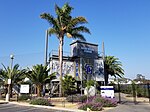2014 Isla Vista killings
The 2014 Isla Vista killings were two misogynistic terror attacks in Isla Vista, California. On the evening of Friday, May 23, 22-year-old Elliot Rodger killed six people and injured fourteen others by gunshot, stabbing and vehicle ramming near the campus of the University of California, Santa Barbara (UCSB), before fatally shooting himself.Rodger stabbed three men to death in his apartment, apparently one by one on their arrival. About three hours later, he drove to a sorority house and, after failing to get inside, shot three women outside, two of whom died. He next drove past a nearby deli and shot a male student inside to death. He then began to drive through Isla Vista, shooting and wounding several pedestrians from his car and striking several others with his car. He exchanged gunfire with police twice, and he was injured in the hip. After his car crashed into a parked vehicle, he was found dead inside with a self-inflicted gunshot wound to the head. Before driving to the sorority house, Rodger uploaded a video to YouTube titled "Elliot Rodger's Retribution", in which he outlined his planned attack and his motives. He explained that he wanted to punish women for rejecting him, and sexually active men because he envied them. He also emailed a lengthy autobiographical manuscript to friends, his therapist and family members; the document appeared on the Internet and became widely known as his manifesto. In it, he described his childhood, family conflicts, frustration over his inability to find a girlfriend, his hatred of women, his contempt for couples (particularly interracial couples) and his plans for what he described as "retribution". In February 2020, the International Centre for Counter-Terrorism at the Hague retroactively described the killings as an act of misogynist terrorism. The US Secret Service describes it as "misogynistic extremism."
Excerpt from the Wikipedia article 2014 Isla Vista killings (License: CC BY-SA 3.0, Authors).2014 Isla Vista killings
Camino Pescadero,
Geographical coordinates (GPS) Address Nearby Places Show on map
Geographical coordinates (GPS)
| Latitude | Longitude |
|---|---|
| N 34.412 ° | E -119.859 ° |
Address
Camino Pescadero 945
93117
California, United States
Open on Google Maps







